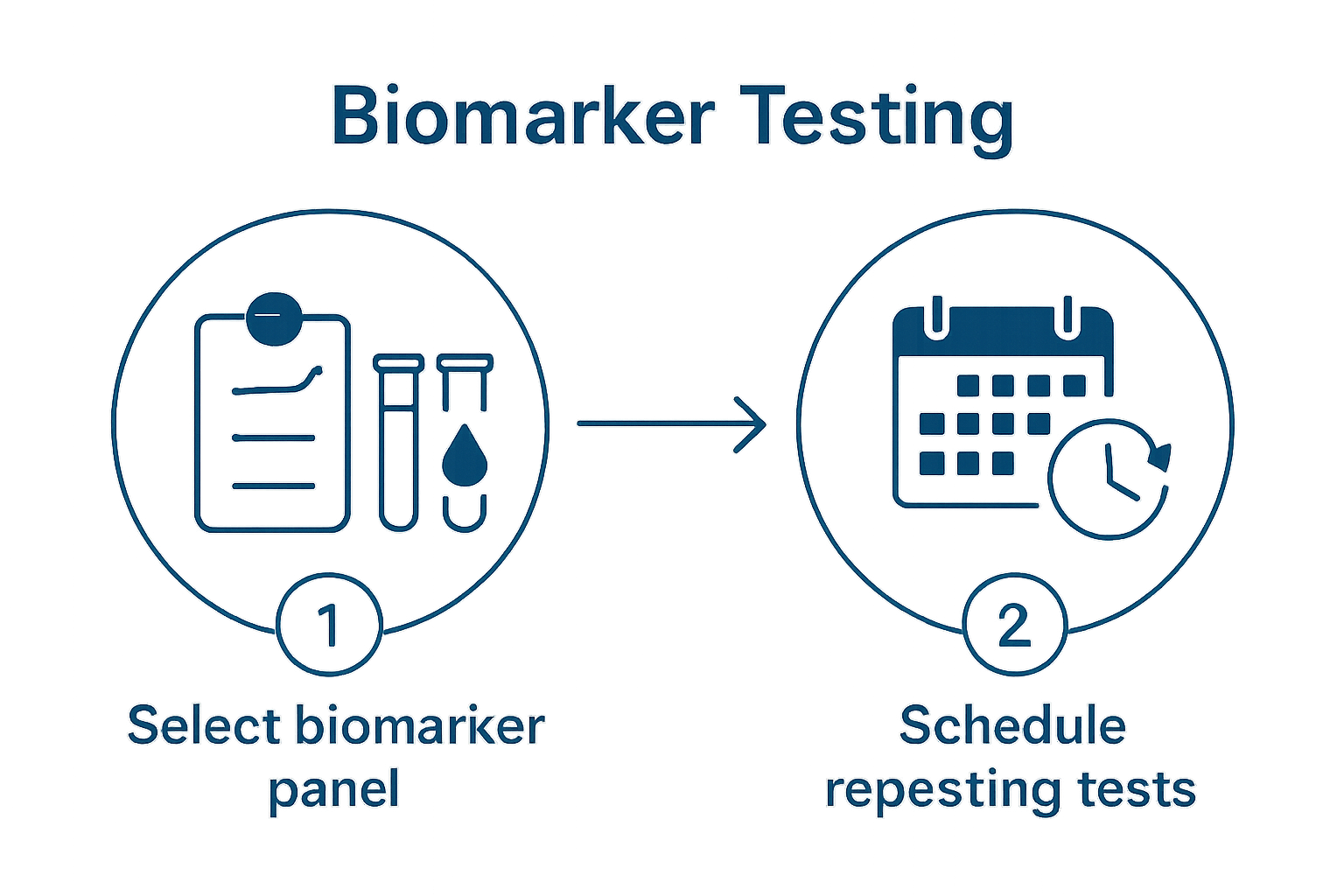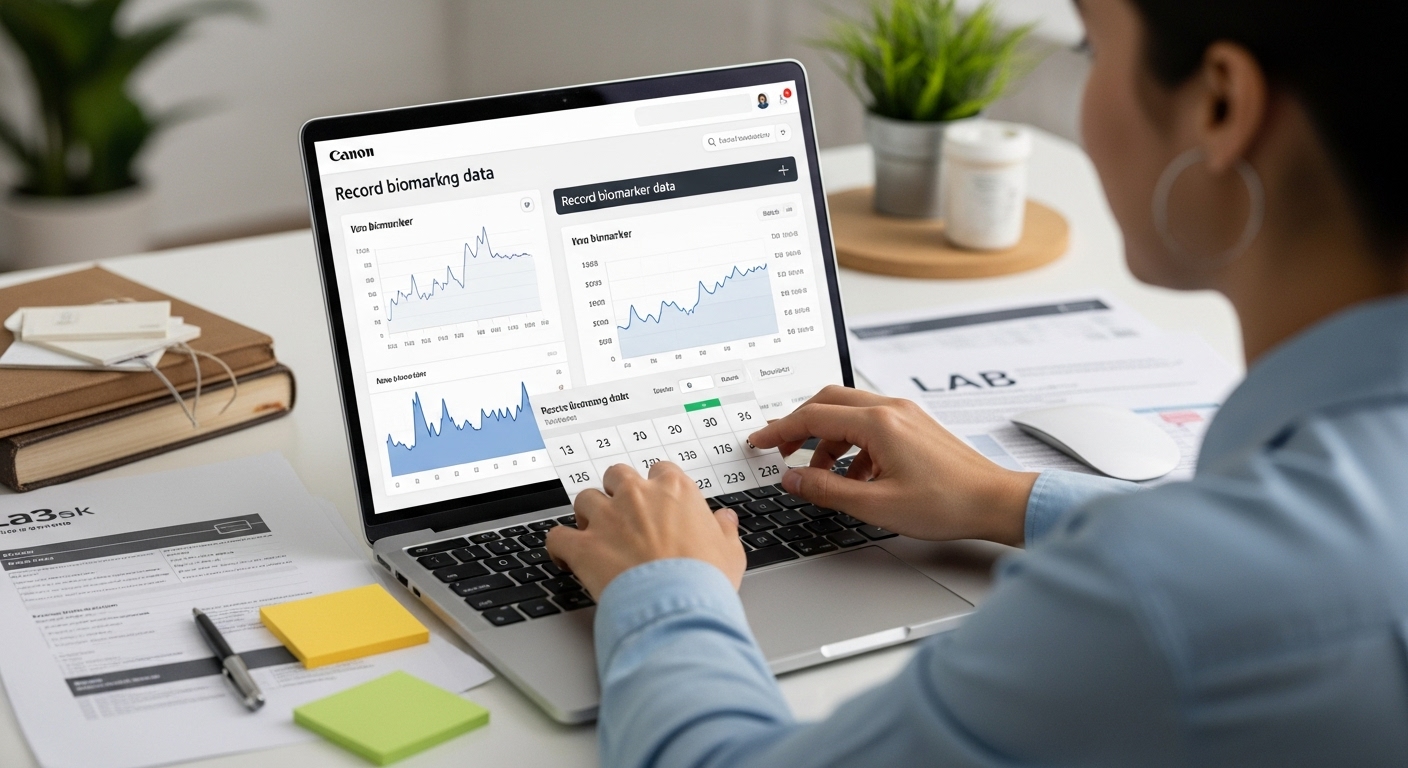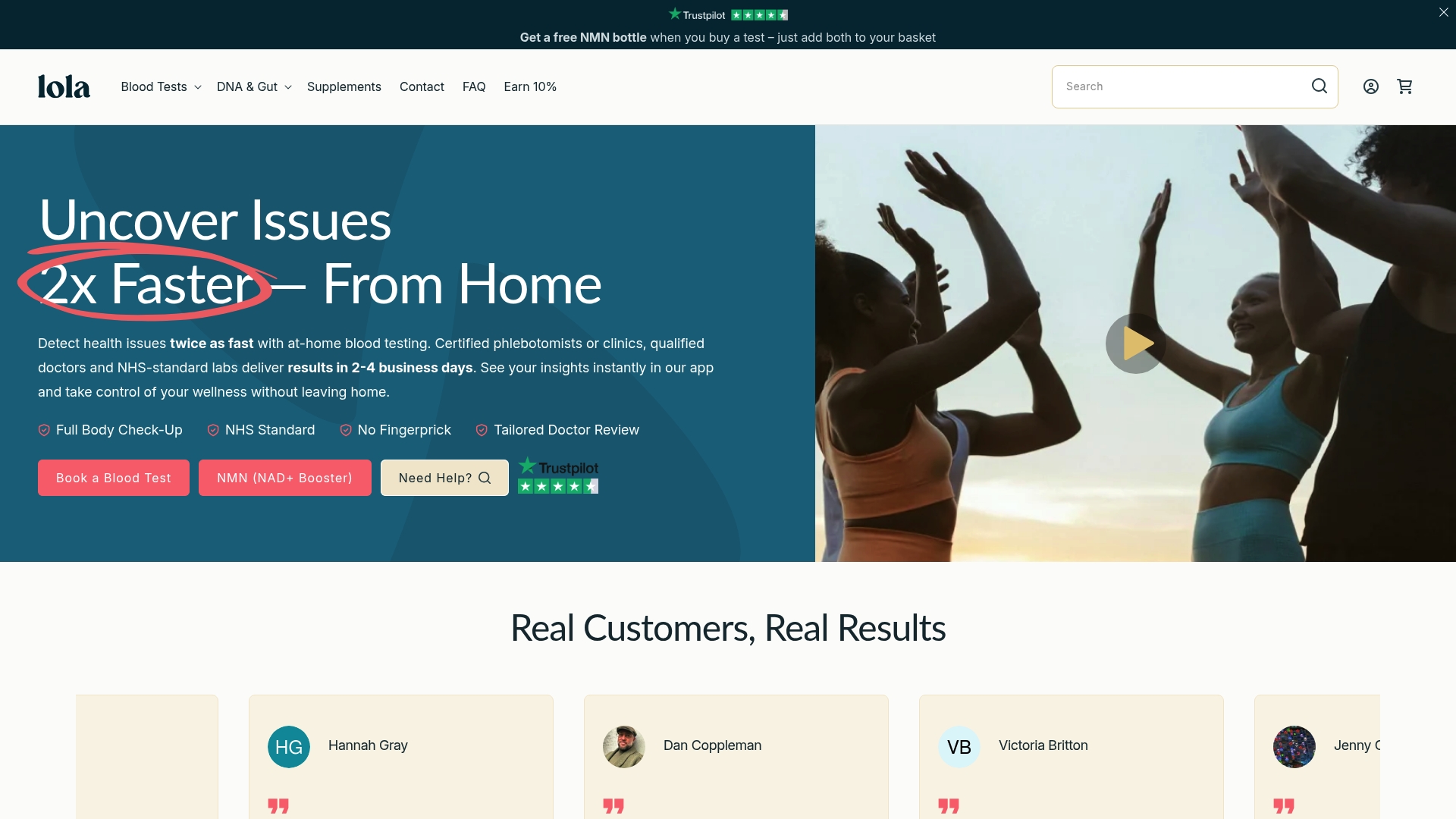Tracking your health with biomarker monitoring is gaining attention for its potential to unleash precise, personalised insights. Most people think health tracking is just another app notification and another blood test. But blood tests have become so advanced that you can now measure dozens of biomarkers from home and spot health changes well before symptoms start. This shift turns sporadic health checks into your own ongoing, scientific feedback loop.
Table of Contents
- Step 1: Identify Key Biomarkers Relevant To Your Goals
- Step 2: Choose Appropriate Testing Methods And Tools
- Step 3: Establish A Consistent Data Collection Schedule
- Step 4: Monitor And Record Biomarker Data Accurately
- Step 5: Analyse Trends And Adjust Health Strategies Accordingly
- Step 6: Review Results And Refine The Monitoring Process
Quick Summary
| Key Point | Explanation |
|---|---|
| 1. Identify relevant biomarkers for goals | Assess your health objectives to select specific biomarkers that align with cardiovascular, metabolic, or hormonal health needs. |
| 2. Choose reliable testing methods | Opt for blood tests and advanced at-home solutions that offer comprehensive, accurate, and repeatable results for effective monitoring. |
| 3. Establish a consistent data collection schedule | Design a systematic timeline for testing frequency that aligns with health objectives to track trends and changes effectively. |
| 4. Monitor and record data accurately | Use digital tools for secure data management, ensuring comprehensive documentation of results and contextual factors impacting biomarkers. |
| 5. Regularly analyse trends and refine strategies | Review collected data to identify patterns and make adjustments to your health strategies, ensuring a proactive approach to health management. |
Step 1: Identify key biomarkers relevant to your goals
Identifying the right biomarkers transforms your health monitoring from a generic process to a personalised strategy. Your biomarker monitoring workflow begins with understanding which specific indicators align most closely with your individual health objectives and potential risk factors.
Start by conducting a comprehensive self-assessment of your current health status, medical history, and primary wellness goals. Are you focused on cardiovascular health, metabolic performance, hormonal balance, or early disease detection? Each objective requires a targeted approach to biomarker selection.
 For instance, someone tracking cardiovascular risk might prioritise lipid panels, inflammatory markers, and cholesterol levels, while an individual monitoring metabolic health would concentrate on glucose metabolism, insulin sensitivity, and liver function indicators.
For instance, someone tracking cardiovascular risk might prioritise lipid panels, inflammatory markers, and cholesterol levels, while an individual monitoring metabolic health would concentrate on glucose metabolism, insulin sensitivity, and liver function indicators.
Consult with healthcare professionals who can provide expert guidance in selecting the most relevant biomarkers for your specific profile. Our comprehensive guide to understanding lab panels offers deeper insights into how different biomarkers interconnect and signal various physiological processes.
Professional input helps eliminate guesswork and ensures you are tracking the most meaningful indicators for your unique health landscape.Key verification criteria for successful biomarker identification include:
- Clear alignment between selected biomarkers and your specific health goals
- Professional validation of your chosen monitoring approach
- Comprehensive understanding of each biomarker’s significance and potential implications
Remember that biomarker selection is not a one-size-fits-all process. Your workflow must be as unique as your physiological makeup, adapting and evolving with your changing health needs and emerging medical understanding.
Step 2: Choose appropriate testing methods and tools
Selecting the right testing methods and tools is crucial in developing an effective biomarker monitoring workflow. This step transforms your health insights from generic measurements to precise, actionable intelligence about your physiological state.
Begin by evaluating the spectrum of testing options available, ranging from traditional clinical laboratory tests to advanced at-home diagnostic solutions. Blood tests remain the gold standard for comprehensive biomarker analysis, offering deep insights into multiple physiological systems simultaneously. Consider both invasiveness, accuracy, and convenience when making your selection. At-home testing kits have revolutionised personal health monitoring, providing sophisticated analysis without extensive medical appointments.
Why blood tests for heart disease matter can provide additional context about the importance of precise testing methodologies. Professional-grade tests typically offer more comprehensive panels, allowing you to capture nuanced biochemical interactions that simpler tests might miss.
Your testing method selection should prioritise three critical factors: reliability, comprehensiveness, and repeatability. Look for testing approaches that provide:
- Multiple biomarker measurements in a single test
- Consistent and reproducible results
- Clear, interpretable reporting mechanisms
- Options for tracking changes over time
Technology has dramatically expanded testing possibilities. Advanced diagnostic tools now enable molecular-level analysis, allowing individuals to track intricate biochemical shifts with unprecedented precision. Digital health platforms increasingly integrate testing results, creating comprehensive health monitoring ecosystems that transform raw data into meaningful insights.
Verify your testing method selection by confirming it meets your specific health monitoring objectives, provides statistically significant data, and aligns with recommended clinical standards. The right testing approach becomes your gateway to proactive, personalised health management.
Below is a comparison of traditional clinical laboratory tests and advanced at-home diagnostic solutions to help you select the most suitable method for your biomarker monitoring workflow.
| Testing Method | Reliability | Comprehensiveness | Convenience | Reporting Mechanism |
|---|---|---|---|---|
| Clinical laboratory tests | Very high | Broad, full panels | Lower, requires visit | Detailed, professional |
| At-home diagnostic kits | High (if regulated) | Broad, selected panels | Very high, at home | Clear, digital or paper |
| Professional-grade at-home blood tests | Highest | Comprehensive | High, nurse visit | Rapid, doctor-reviewed |
| Basic at-home finger-prick tests | Moderate | Basic, limited markers | Very high | Simple, often digital |
Step 3: Establish a consistent data collection schedule
A robust biomarker monitoring workflow hinges on establishing a systematic and predictable data collection schedule.
 Consistency transforms sporadic measurements into meaningful health insights, allowing you to track trends, detect subtle changes, and understand your physiological dynamics over time.
Consistency transforms sporadic measurements into meaningful health insights, allowing you to track trends, detect subtle changes, and understand your physiological dynamics over time.
Frequency is fundamental when designing your data collection approach. Most health professionals recommend baseline testing followed by periodic reassessments tailored to your specific health goals and biomarker types. For instance, cardiovascular and metabolic markers might require quarterly testing, while hormonal panels could be evaluated semi-annually.
The key is creating a schedule that balances comprehensive monitoring with practical implementation.Our guide to women’s health blood tests provides additional context on scheduling considerations across different health profiles. Technology now enables more sophisticated tracking, with digital health platforms offering automated reminders and seamless scheduling to maintain your monitoring rhythm.
Consider these critical scheduling elements when designing your biomarker monitoring workflow:
- Align testing frequency with your specific health objectives
- Factor in seasonal variations and potential lifestyle changes
- Create buffer periods for unexpected health events or additional testing
- Integrate testing schedules with existing healthcare interactions
Successful data collection scheduling requires flexibility and commitment. External factors like stress, dietary changes, and seasonal variations can influence biomarker results, so build adaptability into your monitoring strategy. Documenting not just the test results but the contextual factors surrounding each testing period provides a more holistic understanding of your health trajectory.
Verify your data collection schedule’s effectiveness by ensuring it produces consistent, comparable data points, allows for meaningful trend analysis, and remains sustainable within your lifestyle constraints. A well-designed schedule transforms biomarker monitoring from a sporadic activity into a strategic health management tool.
The following checklist table summarises essential criteria for an effective and sustainable biomarker data collection schedule, supporting consistency and accuracy in your health monitoring routine.
| Checklist Item | Description |
|---|---|
| Aligned testing frequency | Matches individual health objectives and biomarker characteristics |
| Seasonal/lifestyle considerations | Accounts for variations due to life events or environmental shifts |
| Buffer periods for unexpected events | Includes extra time for illness, travel, or extra assessments |
| Integration with existing healthcare schedules | Coordinates with other routine health interactions |
| Flexibility for external factors | Adaptable for dietary, stress, and seasonal influences |
| Document contextual factors | Records diet, exercise, stress near test times |
Step 4: Monitor and record biomarker data accurately
Accurate data monitoring and recording form the backbone of an effective biomarker tracking workflow, transforming raw measurements into meaningful health insights. This critical step bridges the gap between data collection and actionable health intelligence.
Digital tracking tools have revolutionised how individuals manage their health data. Modern platforms enable precise, secure recording of biomarker results, allowing for instant comparison, trend analysis, and comprehensive health visualization. Learn more about at-home blood testing technologies to understand the sophisticated tools available for accurate data management.
Establish a standardised recording system that captures not just the numerical results, but contextual information that might influence your biomarkers. Comprehensive documentation should include test date, specific testing conditions, recent lifestyle factors like diet, exercise, stress levels, and any medications that might impact your results. This holistic approach provides a nuanced understanding of your physiological changes.
Key elements for accurate biomarker data recording include:
- Use dedicated health tracking applications or spreadsheets
- Maintain a consistent recording format
- Include detailed contextual notes with each measurement
- Protect your data privacy and maintain secure storage
Consider implementing a colour-coded or graphical tracking system that allows rapid visual interpretation of your biomarker trends. Some advanced digital health platforms offer automated trend analysis, highlighting significant changes or potential areas of concern. This approach transforms raw data into an intuitive health monitoring dashboard.
Verify your data recording process by ensuring each entry is complete, consistent, and follows your predefined documentation standards. A robust monitoring system will provide clear, traceable insights into your health trajectory, empowering proactive wellness management.
Step 5: Analyse trends and adjust health strategies accordingly
Analysing biomarker trends represents the pivotal moment where collected data transforms into actionable health intelligence. This step moves beyond passive observation, enabling you to proactively understand and influence your physiological trajectory.
Trend analysis requires a holistic perspective, examining not just individual biomarker measurements but their interconnected relationships. Look for patterns, subtle shifts, and potential early warning signals that might indicate emerging health dynamics. Explore our comprehensive health screening checklist to understand the broader context of interpreting health indicators.
Utilise advanced data visualization tools that can translate complex biochemical data into intuitive graphics. Modern health platforms offer sophisticated trend analysis algorithms that can highlight statistically significant changes, compare your results against population baselines, and predict potential future health scenarios. Machine learning technologies are increasingly enabling more nuanced, predictive health insights.
Critical considerations for effective trend analysis include:
- Identify both short-term fluctuations and long-term trajectories
- Correlate biomarker changes with lifestyle modifications
- Seek professional interpretation for complex or unexpected results
- Maintain a forward-looking, proactive mindset
Consider scheduling periodic consultations with healthcare professionals who can provide expert interpretation of your biomarker trends. While personal tracking offers invaluable insights, professional guidance ensures comprehensive understanding and appropriate strategic adjustments.
Verify the effectiveness of your trend analysis by demonstrating a clear, logical connection between observed biomarker changes and subsequent lifestyle or medical interventions. A successful approach transforms raw data into a dynamic, personalised health management strategy, empowering you to make informed decisions about your wellness journey.
Step 6: Review results and refine the monitoring process
Reviewing and refining your biomarker monitoring workflow is a dynamic process that transforms raw data collection into a sophisticated, personalised health management strategy. This final step ensures your approach remains adaptive, precise, and aligned with your evolving health objectives.
Systematic evaluation is the cornerstone of an effective monitoring refinement process. Set aside dedicated time quarterly or semi-annually to conduct a comprehensive review of your biomarker tracking approach. Examine not just the results, but the entire workflow methodology, identifying potential improvements in testing frequency, data recording techniques, and analytical strategies. Understand what comprehensive wellness panels include to benchmark your current approach against best practices.
Consider both quantitative and qualitative aspects during your review. Numerical trends are crucial, but equally important are subjective factors like how easily you maintained the monitoring schedule, the clarity of results interpretation, and the overall impact on your health awareness and decision-making. Technology now offers sophisticated analysis tools that can help streamline this review process, providing nuanced insights into your monitoring workflow’s effectiveness.
Key refinement considerations include:
- Assess the relevance of currently monitored biomarkers
- Evaluate the frequency and timing of your testing schedule
- Review the tools and technologies used for data collection
- Consider feedback from healthcare professionals
Remain open to significant workflow adjustments. What worked effectively six months ago might require modification based on new health insights, technological advancements, or changes in your personal health landscape. The most successful biomarker monitoring approaches are those that remain flexible and responsive to emerging information.
Verify the effectiveness of your review by demonstrating a clear evolution in your monitoring strategy. A refined workflow should feel more intuitive, provide deeper insights, and ultimately empower you to make more informed health decisions with greater confidence and precision.
Turn Your Biomarker Tracking into Lasting Health Results
Do you feel overwhelmed trying to identify the right biomarkers for your unique wellbeing goals or struggle to find truly accurate and timely testing? The article highlighted how personalisation, consistency, and actionable insights are key to effective health monitoring. Yet, many are stuck with generic tests or unclear results that leave questions unanswered and routines difficult to maintain.

At Lola Health, we make optimising your biomarker workflow simple and effective. Choose from comprehensive at-home and clinic blood tests expertly designed to cover cardiovascular, hormonal, metabolic and immune markers.
Access seamless online ordering, nurse visits at your convenience, and receive rapid results reviewed by doctors for trusted clarity — every time.Start your proactive health journey today. Visit our main site Lola Health to explore all test options or learn more about how at-home blood testing technologies empower you. Take control now and transform your health data into real, meaningful progress.
Frequently Asked Questions
What are biomarkers, and why are they important for health monitoring?
Biomarkers are specific indicators in the body that reflect physiological processes. They are crucial for health monitoring as they provide insights into individual health status, allowing for personalised health strategies and early disease detection.
How do I choose the right biomarkers for my health goals?
Start by assessing your current health status, medical history, and specific wellness objectives. Consult healthcare professionals for expert guidance on selecting biomarkers that align with your individual health profile, such as cardiovascular health or metabolic performance.
What testing methods are available for monitoring biomarkers?
Testing methods include traditional clinical laboratory tests and advanced at-home diagnostic solutions. Blood tests are the gold standard for comprehensive analysis, but at-home testing kits also offer convenience and sophisticated analysis.
How often should I collect biomarker data to ensure effectiveness?
The frequency of data collection depends on your health goals and the type of biomarkers monitored. Most professionals recommend baseline testing followed by periodic reassessments, which could be quarterly for cardiovascular or metabolic markers, and semi-annually for hormonal panels.


